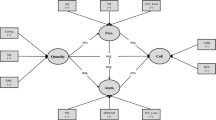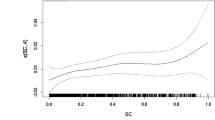Abstract
It has been recognized that the link between information technology (IT) investment and firm performance is indirect due to the effect of mediating and moderating variables. For example, in the banking industry, the IT-value added activity helps to effectively generate funds from the customer in the forms of deposits. Profits then are generated by using deposits as a source of investment funds. Traditional efficiency models, such as data envelopment analysis (DEA), can only measure the efficiency of one specific stage when a two-stage production process is present. We develop an efficiency model that identifies the efficient frontier of a two-stage production process linked by intermediate measures. A set of firms in the banking industry is used to illustrate how the new model can be utilized to (i) characterize the indirect impact of IT on firm performance, (ii) identify the efficient frontier of two principal value-added stages related to IT investment and profit generation, and (iii) highlight those firms that can be further analyzed for best practice benchmarking.
Similar content being viewed by others
References
J.Y. Bakos and C.F. Kemerer, Recent applications of economic theory in information technology research, Decision Support Systems 8 (1992) 365-386.
R.D. Banker, A. Charnes and W.W. Cooper, Some models for the estimation of technical and scale inefficiencies in data envelopment analysis, Management Science 30 (1984) 1078-1092.
R.D. Banker, W.W. Cooper, L.M. Seiford, R.M. Thrall and J. Zhu, Returns to scale in different DEA models, European Journal of Operational Research (2002), to appear.
R.D. Banker, R.J. Kauffman and R.C. Morey, Measuring gains in operational efficiency from information technology: A study of the positran deployment at Hardee's Inc., Journal of Management Information Systems 7 (1990) 29-54.
R.D. Banker and R.J. Kauffman, Case study of electronic banking at Meridian Cancorp, Information and Software Technology 33 (1991) 200-224.
E.R. Berndt and C.J. Morrison, High-tech capital formation and economic performance in US manufacturing industries: An exploratory analysis, Journal of Econometrics 33 (1995) 7-29.
T.F. Bresnahan, E. Brynjolfsson and L. Hitt, Information technology, workplace organization, and the demand for skilled labor: Firm-level evidence, Quarterly Journal of Economics 117 (2002) 339-377.
E. Brynjolfsson, The productivity paradox of information technology, Communications of the ACM 36 (1993) 67-77.
E. Brynjolfsson and L. Hitt, Paradox lost? Firm-level evidence on the returns to information systems spending, Management Science 42 (1996) 541-558.
E. Brynjolfsson and L. Hitt, Beyond the productivity paradox, Communications of the ACM 41 (1998) 49-56.
A. Charnes, W.W. Cooper, A.Y. Lewin and L.M. Seiford, Data Envelopment Analysis: Theory, Methodology and Applications (Kluwer Academic, Boston, 1994).
A. Charnes, W.W. Cooper and E. Rhodes, Measuring the efficiency of decision making units, European Journal of Operational Research 2 (1978) 429-444.
C.M. Christensen, F.F. Suárez and J.M. Utterback, Strategies for survival in fast-changing industries, Management Science 44 (1998) S207-S221.
W. Cron and M. Sobol, The relationship between computerization and performance: A strategy for maximizing economic benefits of computerization, Information and Management 6 (1983) 171-181.
R. D'Aveni and R. Gunther, Hypercompetition: Managing the Dynamics of Strategic Maneuvering(The Free Press, New York, 1994).
R. Färe, S. Grosskopf and C.A.K. Lovell, Production Frontiers(Cambridge University Press, Cambridge, 1994).
V. Grover, From business reengineering to business process change management: A longitudinal study of trends and practices, IEEE Transactions on Engineering Management 46 (1999) 36-46.
S.E. Harris and J.L. Katz, Organizational performance and information technology investment intensity in the insurance industry, Organization Science 2 (1991) 263-295.
L.M. Hitt and E. Brynjolfsson, Productivity, business profitability, and consumer surplus: Three different measures of information technology value, MIS Quarterly 20 (1996) 121-143.
R.J. Kauffman, J. McAndrews and Y.-M. Wang, Opening the 'black box' of network externalities in network adoption, Information Systems Research 11 (2000) 61-83.
R.J. Kauffman and P.Weill, An evaluative framework for research on the performance effects of information technology investment, in: Proceedings of the 10th International Conference on Information Systems, Boston, MA (December 1989) pp. 377-388.
F.R. Lichtenberg, The output contributions of computer equipment and personnel: A firm-level analysis, Economic Innovations and New Technology 3 (1995) 201-217.
J.D. McKeen and H.A. Smith, The relationship between information technology use and organizational performance, in: Strategic Information Technology Management: Perspectives or Organizational Growth and Competitive Advantage, eds. R.D. Banker, R.J. Kauffman and M.A. Mahmood (Idea Group Publishing, London, England, 1993).
L.M. Seiford and J. Zhu, Marketability and profitability of the top 55 US commercial banks, Management Science 45 (1999) 1270-1288.
L.M. Seiford and J. Zhu, An investigation of returns to scale in DEA, OMEGA 27 (1999) 1-11.
S.M. Shafer and T.A. Byrd, A framework for measuring the efficiency of organizational investments in information technology using data envelopment analysis, OMEGA 28 (2000) 125-141.
P. Tallon, K.L. Kraemer and V. Gurbaxani, Executives' perceptions of the business value of information technology: A process-oriented approach, Journal of Management Information Systems 16 (2000) 145-173.
C.H. Wang, R. Gopal and S. Zionts, Use of data envelopment analysis in assessing information technology impact on firm performance, Annals of Operations Research 73 (1997) 191-213.
P. Weill, Strategic investment in information technology: An empirical study, Information Age 12 (1990) 141-147.
J. Zhu, Multi-factor performance measure model with an application to fortune 500 companies, European Journal of Operational Research 123 (2000) 105-124.
J. Zhu, Super-efficiency and DEA sensitivity analysis, European Journal of Operational Research 129 (2001) 443-455.
J. Zhu, Quantitative Models for Performance Evaluation and Benchmarking: Data Envelopment Analysis with Spreadsheets (Kluwer Academic, Boston, 2002).
Author information
Authors and Affiliations
Corresponding author
Rights and permissions
About this article
Cite this article
Chen, Y., Zhu, J. Measuring Information Technology's Indirect Impact on Firm Performance. Information Technology and Management 5, 9–22 (2004). https://doi.org/10.1023/B:ITEM.0000008075.43543.97
Issue Date:
DOI: https://doi.org/10.1023/B:ITEM.0000008075.43543.97




